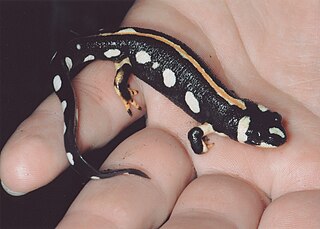
Salamandridae is a family of salamanders consisting of true salamanders and newts. Salamandrids are distinguished from other salamanders by the lack of rib or costal grooves along the sides of their bodies and by their rough skin. Their skin is very granular because of the number of poison glands. They also lack nasolabial grooves. Most species of Salamandridae have moveable eyelids but lack lacrimal glands.

Beilun District (help·info) is a district of Ningbo in Zhejiang province, China. It is dominated by Beilun port, an international port of the easternmost edge of the southern coast of Hangzhou Bay. It primarily services the regional city of Ningbo. Beilun district has 380,000 permanent residents and 850,000 residents. Beilun district has a land area of 615 square kilometers, a sea area of 258 square kilometers and a coastline of 150 kilometers. It is the largest sea area and the longest coastline area within the jurisdiction of Ningbo city.

The sword-tail newt, sword-tailed newt, yellow-bellied newt, or Okinawa newt is a species of true salamander from the Ryukyu Archipelago in Japan.

The striped newt is a species of aquatic salamander native to the southeastern United States. It is a close relative of the eastern newt, with which it shares territory, and can be distinguished from the latter by the presence of red stripes running down the sides of its back and red spots on its back that lack a black outline.

The Chuxiong fire-bellied newt is a species of salamander in the family Salamandridae that is endemic to China where it is only found in Guizhou and Yunnan. It also occurs in Kunming Lake.
The Dayang newt is a rare species of salamander in the family Salamandridae, endemic to China. It is known from Jiexi County in eastern Guangdong from where it was collected in 1936 and described as a new species in 1983. More recently, it has also been found from Dehua County in central Fujian.

Anderson's crocodile newt, Anderson's newt, Ryukyu spiny newt, or Japanese warty newt is a species of salamander in the family Salamandridae found in the Ryukyu Islands of Japan, and, at least formerly, Mount Guanyin in northern Taiwan, where it is now believed to be extinct.

Neurergus kaiseri, the Luristan newt, Kaiser's mountain newt, Kaiser's spotted newt or emperor spotted newt, is a species of very colourful salamander in the family Salamandridae. It is endemic to the southern Zagros Mountains in Iran where it is known from just four streams. Populations of this newt have been declining and the International Union for Conservation of Nature has rated it as "vulnerable". A captive breeding programme has been established in several zoos.
The spot-tailed warty newt is a species of salamander in the family Salamandridae only found in central China. Its natural habitats are subtropical or tropical moist lowland forests and rivers. It is threatened by habitat loss. Female spot-tailed warty newts reach a total length of 155 mm (6.1 in), males are slightly shorter.

The Chinese warty newt is a species of salamander in the family Salamandridae. It is found only in China, with a range extending from Chongqing to Hunan, Anhui, Zhejiang, Fujian, Guangdong, and Guangxi Provinces in Central China. Its natural habitats are subtropical or tropical moist lowland forests, rivers, and freshwater marshes. It is threatened by habitat loss. Female Chinese warty newts reach total length of 151 mm (5.9 in), males are slightly shorter.

The Algerian ribbed newt is a species of salamander in the family Salamandridae found in Algeria and Tunisia. The natural habitats of this newt are rivers, intermittent rivers, swamps, cisterns, freshwater marshes, intermittent freshwater marshes, and ponds. It is threatened by habitat destruction.

Pleurodeles poireti, the Edough ribbed newt or Poiret's newt, is a species of salamander in the family Salamandridae. It is found only in the Edough Massif, in the north east of Algeria.

The black knobby newt is a species of salamanders in the family Salamandridae found in China and Vietnam. Its natural habitats are subtropical or tropical moist lowland forests, subtropical or tropical moist montane forests, freshwater marshes, and intermittent freshwater marshes. It is threatened by habitat loss and overharvesting.
The Hainan knobby newt is a species of salamander in the family Salamandridae. It is found only in the island of Hainan, China. It is known from the Wuzhi Mountains, Diaoluoshan, and Jianfengling. All these locations are nature reserves. Nevertheless, the species is threatened by habitat loss and degradation due to agriculture, clear-cutting and infrastructure development for tourist activities.

Ichthyophis supachaii, or Supachai's caecilian, is a species of caecilian in the family Ichthyophiidae found in Thailand's provinces of Nakhon Si Thammarat and Trang, and possibly Malaysia.

A newt is a salamander in the subfamily Pleurodelinae. The terrestrial juvenile phase is called an eft. Unlike other members of the family Salamandridae, newts are semiaquatic, alternating between aquatic and terrestrial habitats. Not all aquatic salamanders are considered newts, however. More than 100 known species of newts are found in North America, Europe, North Africa and Asia. Newts metamorphose through three distinct developmental life stages: aquatic larva, terrestrial juvenile (eft), and adult. Adult newts have lizard-like bodies and return to the water every year to breed, otherwise living in humid, cover-rich land habitats.













